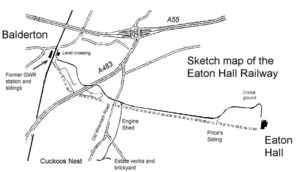Eaton Hall Railway
The Eaton Hall Railway was an early 15 inch gauge narrow gauge estate railway built in 1896 at Eaton Hall in Cheshire.
It was built for the Duke of Westminster by Sir Arthur Percival Heywood, who had pioneered the fifteen inch gauge with his Duffield Bank Railway, and connected the hall to the GWR station sidings at Balderton on their Shrewsbury to Chester Line, some three miles away.
Laying the line
The total length of the line was four and a half miles, with the addition of several branches including one long one to the brick store and estate workshop at Cuckoo's Nest.
The track was steel flat-bottomed rail of 16 1/2 lb per yard, attached by spring clips to steel sleepers, three feet six and a half inches wide, spaced at 2 foot 3 inch centres. Pointwork was prepared at the workshop in Duffield (for which Heywood charged £7.75 each), and carried to site. The maximum gradient was 1 in 70, Eaton Hall being 51 feet above the sidings at Balderton.
For much of its length it followed the main driveway and crossed the park, including the major driveways. Therefore the line had to be as unobtrusive as possible and was laid level with the ground with a central drainage pipe beneath. The ballast was red furnace cinder, five to six inches deep and four feet wide. On leaving the park the line was embanked. The line was not fenced - where it crossed between fields it was carried on girders over a deep ditch to prevent cattle straying.
There were bridges over one or two streams, the longest beeing 28 feet, but it crossed roadways on the level, at one point the main Wrexham road. Although Heywood had obtained wayleave , it could only be a temporary arrangement, since, for a private railway, the council was not able to enter in an agreement which bound its successors. Heywood therefore campaigned for a clause in the proposed Light Railway Bill which would allow permission for public road crossings to be granted in perpetuity.
Rolling stock
The first engine was "Katie", an 0-4-0 with Stephenson valvegear. Following this were two identical 0-6-0 locomotives, "Shelagh" and "Ursula". Further details are given below. Katie proved capable of handling up to 40 tons on the level, or 20 tons on the gradient, at a speed of around 10mph. Under test, twenty mph was achieved in safety.
All rolling stock was built to negotiate curves of twenty five foot minimum radius. Self-acting coupler-buffers were fitted and measures were taken to ensure interchangeability of parts.
Thirty open waggons were provided each carrying about 16 tons. The sides were removable to allow them to be used as flats, and fittings were supplied to carry long items such as timber. In addition a brake van was supplied, with some small wagons and a parcel van. Finally, a bogie passenger vehicle some twenty feet long seating sixteen people.
Operation
The design estimate for the line was around 5,000 tons per year, mainly coal, timber, road metal and bricks. To Heywood's mind it was the ideal application for this gauge of railway.
The Eaton Hall railway closed in 1947.
A new 15 inch railway, named the Eaton Park Railway was built in 1994 with a replica of Katie. It is not available for use by the public except on the various garden open days. The new line consists of a large loop with a spur leading to the engine shed. The latter follows a small part of the original route.
The original Katie was sold to the newly-built Ravenglass and Eskdale Railway and then in 1922 to the Llewellyn Miniature Railway in Southport. She is currently back at Ravenglass being rebuilt using the original frames and various parts from other Heywood locomotives, while a replica is being constructed by the Perrygrove Railway in Gloucestershire which was built with Sir Percival's work very much in mind.
Locomotives
- 1896 Katie 0-4-0T boiler 160 psi, grate area 2.12 sq.ft., heating surface 53 sq.ft., cylinders 4.675"x7", wheel diameter 1'3", Stephenson valvegear.
- 1904 Shelagh 0-6-0T boiler 160 psi, grate area 3 sq.ft., heating surface 80 sq.ft., cylinders 5.5"x8", wheel diameter 1'4", Stephenson valvegear.
- 1916 Ursula 0-6-0T as Shelagh
References
- Clayton, H. (1968) The Duffield Bank and Eaton Railways, The Oakwood Press, X19, ISBN 0-85361-034-7
- Heywood, A.P. (1898) Minimum Gauge Railways, 3rd Ed., Derby: Bemrose. Republished (1974) by Turntable Enterprises, ISBN 0-902844-26-1
- Smithers, Mark (1995) Sir Arthur Heywood and the Fifteen Inch Gauge Railway, Plateway Press, ISBN 1-871980-22-4.

